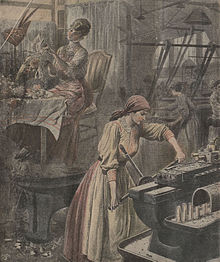Women in France

A portrait about the social classes of French women in 1916
|
|
| Gender Inequality Index | |
|---|---|
| Value | 0.083 (2012) |
| Rank | 9th |
| Maternal mortality (per 100,000) | 8 (2010) |
| Women in parliament | 25.1% (2012) |
| Females over 25 with secondary education | 75.9% (2010) |
| Women in labour force | 60.6% (employment rate OECD definition, 2015) |
| Global Gender Gap Index | |
| Value | 0.7089 (2013) |
| Rank | 45th out of 144 |
The roles of women in France have changed throughout history.
The traditional role of women in French society involves domestic duties such as housekeeping, preparation of meals in the customary fashion that involves a "succession of courses eaten one at a time", child rearing, harvesting of crops, and tending to farm animals. Upon the onset of the industrial revolution in France, women's role changed with them becoming domestic helpers, factory workers, and washerwomen. This did not generally include women who had "bourgeois" status, because these women often became dependent on the financial support of their husbands; such women of upper-class status also had the tendency to send their own "children to wet nurses until" weaned. Further changes to the status of women in France became apparent in 1944, when French women gained the right to vote. But it was only during the 1960s when they won the right to work without getting permission from their husbands, in addition to the right to open personal bank accounts. At present, due to effective health care provision in the country, the life-span of women is at an average of 80.9 years old. So-called "infant allowances" are available to subscribing pregnant women and their newborn children. In 1988, the unemployment rate among the French population was described to be "higher among women". However, in modern-day France, women who have attained a "suitable level of education" and training are gaining prominent positions in the fields of business and the engineering industry, particularly within Paris, the capital city of France.
Educational aspirations were on the rise and were becoming increasingly institutionalised in order to supply the church and state with the functionaries to serve as their future administrators. Girls were schooled too, but not to assume political responsibility. Girls were ineligible for leadership positions and were generally considered to have an inferior intellect to their brothers. France had many small local schools where working-class children - both boys and girls - learned to read, the better "to know, love, and serve God." The sons and daughters of the noble and bourgeois elites were given gender-specific educations: boys were sent to upper school, perhaps a university, while their sisters - if they were lucky enough to leave the house - would be sent to board at a convent with a vague curriculum. The Enlightenment challenged this model, but no real alternative was presented for female education. Only through education at home were knowledgeable women formed, usually to the sole end of dazzling their salons.
...
Wikipedia
